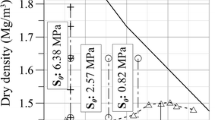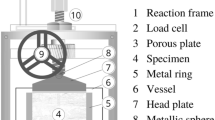Abstract
An apparatus and experimental setup were developed to carry out a series of extremely slow and long-lasting swelling, creep or chemo-mechanics tests simultaneously. The equipment was designed specifically for investigating the behaviour of sulphatic claystones. The tests will take at least 10–15 years to complete and will provide unprecedented information about the so-called swelling law, i.e. the relationship between swelling strain and swelling stress. The swelling law is very important for designing tunnels in swelling rock. Our knowledge of the swelling law, however, is only sufficiently reliable with respect to claystones without anhydrite (e.g. marls, opalinus clay). The swelling law for sulphatic claystones remains unknown, even in qualitative terms. This is due to the underlying physico-chemical mechanisms, which are fundamentally different from those of purely argillaceous rocks. Another reason is the extremely long duration of the swelling process of clay-sulphate rocks, which makes systematic field or laboratory investigations very difficult. In order to close this knowledge gap, a series of 25 long-term simultaneous swelling tests has been started.



















Similar content being viewed by others
Abbreviations
- F :
-
Repulsive force between clay platelets
- H :
-
Height of sample
- p :
-
Swelling pressure
- p max :
-
Maximum swelling pressure
- t :
-
Time
- u :
-
Tunnel invert heave
- δ:
-
Distance between clay platelets
- ΔH :
-
Change in height of the sample
- Δp :
-
Support pressure
- Δu :
-
Tunnel invert heave
- εswell :
-
Swelling strain
- σax :
-
Axial stress
References
Aegerter & Bosshardt AG, Gruner AG (2005) Chienbergtunnel Überwachung, Plan 5535/9926 h. Oberfläche/Tunnel, Tm 400–2294 (Portal Ost), Situation, Längenprofil, Stand 18.11.2005, erstattet an Bau- und Umweltschutzdirektion Kanton Basel-Landschaft
Aegerter & Bosshardt AG, Gruner AG (2006) Chienbergtunnel Überwachung, Statusbericht Stand März 2006, erstattet an Bau- und Umweltschutzdirektion Kanton Basel-Landschaft
Alonso E, Gens A, Berdugo I, Romero E (2005) Expansive behaviour of a sulphated clay in a railway tunnel. In: Proceedings of the 16th international conference on soil mechanics and geotechnical engineering, Osaka, Japan, September 2005, pp 1583–1586
Amstad C, Kovári K (2001) Untertagbau in quellfähigem Fels. Forschungsauftrag 52/94 auf Antrag des Bundesamtes für Strassen (ASTRA)
Anagnostou G (2007) Design uncertainties in tunnelling through anhydritic swelling rocks. Felsbau Rock Soil Eng 25(4):48–54
Anagnostou G, Pimentel E, Serafeimidis K (2010) Swelling of sulphatic claystones—some fundamental questions and their practical relevance. Geomech Tunnelling 3(5):567–572
Aristorenas GV (1992) Time-dependent behavior of tunnels excavated in shale. Doctoral thesis, Massachusetts Institute of Technology, Boston, Massachusetts
Barla M (2008) Numerical simulation of the swelling behaviour around tunnels based on special triaxial tests. Tunn Undergr Space Technol 23:508–521
Bellwald P (1990) A contribution to the design of tunnels in argillaceous rock. Doctoral thesis, Massachusetts Institute of Technology, Boston, Massachusetts
Chiaverio F, Thut A (2010) Rehabilitation using yielding elements of the section in Keuper sediments affected by heave. Geomech Tunnelling 3(5):573–582
Einstein HH (1996) Tunnelling in difficult ground—swelling behaviour and identification of swelling rocks. Rock Mech Rock Eng 29(3):113–124
Fecker E (1980) Quantitative Zusammenhänge zwischen der mineralogischen Umwandlung von Anhydrit in Gips und der Volumenvergrösserung im Tunnelbau. Forschungsbericht Nr. 15.062 R77E des Lehrstuhls für Felsmechanik der Universität (TH) Fridericiana zu Karlsruhe an die Bundesrepublik Deutschland vertreten durch den BMV
Flückiger A, Madsen FT, Nüesch R (1994) Anhydritquellung. Jahresbericht 1994, internal report of the Clay Mineralogy Laboratory of the ETH Zurich
Grob H (1972) Schwelldruck im Belchentunnel. In: Proceedings of the international symposium on underground construction, Lucerne, Switzerland, September 1972, pp 99–119
Huder J, Amberg G (1970) Quellung in Mergel, Opalinuston und Anhydrit. Schweizerische Bauzeitung, 88 Jahrgang Heft 43:975–980
International Society for Rock Mechanics (ISRM) (1994) Comments and recommendations on design and analysis procedures for structures in argillaceous swelling rock. Int J Rock Mech Min Sci Geomech Abstr 31:535–546
International Society for Rock Mechanics (ISRM) (1999) Suggested methods for laboratory testing of swelling rocks. Int J Rock Mech Min Sci 36:291–306
Kirschke D (1987) Laboratory and in situ swelling test for the Freudenstein tunnel. In: Proceedings of the 6th international congress on rock mechanics, Montreal, Canada, August/September 1987, vol 3, pp 1492–1496
Ko SC, Nüesch R, Madsen FT (1997) Tonmineralien und Sulfatgesteine als Ursachen für druckhaftes Verhalten von Gesteinen. Forschungsprojekt Quellverhalten der Juragesteine
Kovári K, Amstad Ch, Anagnostou G (1988) Design/construction methods—tunnelling in swelling rocks. In: Cundall PA et al. (eds) Proceedings of the 29th U.S. Symposium. Key questions in rock mechanics, Minnesota, Minneapolis, June 1988, pp 17–32
Kovári K, Fecker E, Amstad Ch (1986) Freudensteintunnel Versuchsstrecke U1—Mess- und Untersuchungsprogramm. Bericht des IBETH, Fels- und Untertagbau ETH Zürich und der Ges. für Baugeologie und—messtechnik mbH erstattet an die Deutsche Bundesbahn, NBS Mannheim Stuttgart, August 1986
Kovári K, Chiaverio F (2007) Modulares Knautschsystem für Tunnel in stark quellfähigem Gebirge. STUVA TAGUNG’07, Forschung + Praxis 42, bau verlag, Gütersloh, pp 195–200
Langbein R, Peter H, Schwahn HJ (1982) Karbonat- und Sulfatgesteine. Deutscher Verlag für Grundstoffindustrie, Leipzig
Madsen FT (1976) Quelldruckmessung an Tongesteinen und Berechnung des Quelldrucks nach der DLVO—Theorie. Mitteilungen des Institutes für Grundbau und Bodenmechanik der ETH Zürich. Nr. 108, pp 1–65
Madsen FT, Müller-Vonmoos M (1989) The swelling behaviour of clays. Appl Clay Sci 4:143–156
Madsen FT, Nüesch R (1990) Langzeitquellverhalten von Tongesteinen und tonigen Sulfatgesteinen: Mitteilungen des Institutes für Grundbau und Bodenmechanik der ETH Zürich, Nr. 140
Nüesch R, Steiner W, Madsen FT (1995) Long time swelling of anhydritic rocks: mineralogical and microstructural evaluation. In: Proceedings of the 8th international congress on rock mechanics, Tokyo, Japan, September 1995, pp 133–138
Pregl O, Fuchs M, Müller H, Petschl G, Riedmüller G, Schwaighofer B (1980) Dreiaxiale Schwellversuche an Tongesteinen. In: Geotechnik 3, Heft 1
Pimentel E (1996) Quellverhalten von diagenetisch verfestigtem Tonstein. Veröffentlichungen des Institutes für Bodenmechanik und Felsmechanik der Universität Karlsruhe. Heft 139
Pimentel E (2003a) Swelling behaviour of sedimentary rocks under consideration of micromechanical aspects and its consequences on structure design. In: Proceedings of the international symposium on geotechnical measurements and modelling, Karlsruhe, Germany, September 2003, pp 367–374
Pimentel E (2003b) Langzeitschwellversuche an Probenmaterial aus dem Freudensteintunnel. Zwischenbericht für den Zeitraum 0.1.01.2001–01.10.2003. Bericht des Lehrstuhls der Universität Karlsruhe, erstattet an die DB Projekte Süd GmbH
Pimentel E (2007) A laboratory testing technique and a model for the swelling behavior of anhydritic rock. In: Proceedings of the 11th international congress on rock mechanics of the ISRM, Lisbon, Portugal, July 2007, vol 1, pp 14–146
Pimentel E, Anagnostou G (2010) Langzeitquellversuche an anhydritführenden Gesteinen. Forschungsauftrag FGU 2006/001 auf Antrag des Bundesamtes für Strassen (ASTRA), FB 1318
Späth H (1973) Algorithmen für elementare Ausgleichsmodelle. R. Oldenbourg Verlag GmbH, München
van Olphen H (1963) An introduction to clay colloid chemistry. Interscience Publishers, New York
Vögtli B, Jordan P (1996) Quelldruckentwicklung in Ton-und Sulfatgesteinen. Schweizer Ingenieur-und Architektenverein 18:350–352
Wahlen R (2009) Validierung eines Berechnungsverfahrens für Tunnelbauwerke in quellfähigem Gebirge. WBI-Print 17. VGE Verlag GmbH
Acknowledgments
The authors appreciate the financial aid and support for this project from FEDRO (the Swiss Federal Road Office), SBB (the Swiss Federal Railways) and the Authorities of the Canton Basel Country.
Author information
Authors and Affiliations
Corresponding author
Rights and permissions
About this article
Cite this article
Pimentel, E., Anagnostou, G. New Apparatus and Experimental Setup for Long-Term Swelling Tests on Sulphatic Claystones. Rock Mech Rock Eng 46, 1271–1285 (2013). https://doi.org/10.1007/s00603-013-0396-5
Received:
Accepted:
Published:
Issue Date:
DOI: https://doi.org/10.1007/s00603-013-0396-5




